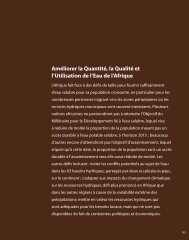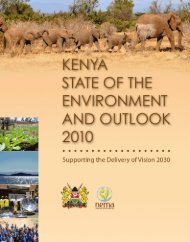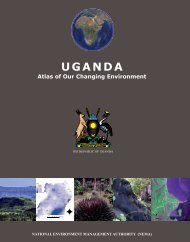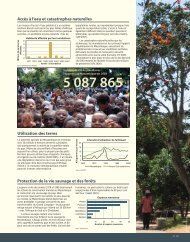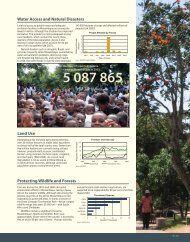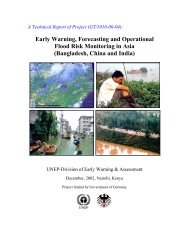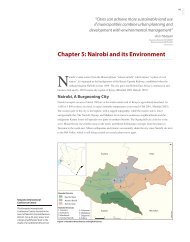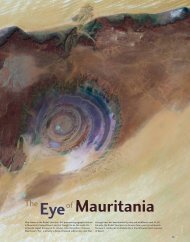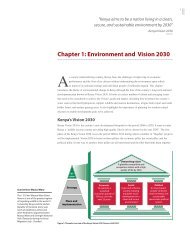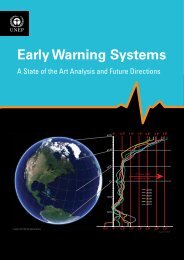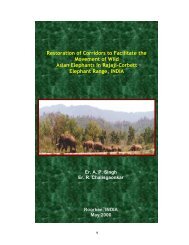To open this publication, click here... - UNEP/GRID-Sioux Falls
To open this publication, click here... - UNEP/GRID-Sioux Falls
To open this publication, click here... - UNEP/GRID-Sioux Falls
Create successful ePaper yourself
Turn your PDF publications into a flip-book with our unique Google optimized e-Paper software.
Praying mantis (Pseudocreobotra ocellata) are<br />
common in many of Rwanda’s forests.<br />
Pavetta bagshawei (ikinesha, umumenyamabuye<br />
in Kinyarwanda, the national language).<br />
Forest Cover (sq. km.)<br />
2 400<br />
2 000<br />
1 600<br />
1 200<br />
800<br />
400<br />
0<br />
1960<br />
1970<br />
1980<br />
1990<br />
1996<br />
1999<br />
Figure 1.8: Trends in<br />
natural forest cover.<br />
2000<br />
2003<br />
2005<br />
2006<br />
2007<br />
2008<br />
2009<br />
2010<br />
Year<br />
Akagera National Park<br />
Nyungwe/Cyamudongo<br />
Gallery Forests<br />
Hunting Zone<br />
Gishwati<br />
Volcanoes National Park<br />
Mukura<br />
Source: Republic<br />
of Rwanda<br />
Yoko Watanabe 2011<br />
Yoko Watanabe 2011<br />
Nyungwe Forest National Park is largely densely forested and lush.<br />
Chapter 1: Environmental Profile 9<br />
The gallery forests of eastern Rwanda tumbled from 2 410 km 2 in 1980 to 250 km 2 in 1996. Designated<br />
hunting zones that included specified belts of natural forest were gradually reduced by 300 km 2<br />
(47 per cent) over a 30-year period from 640 km 2 in 1960 to 340 km 2 in 1990. In 1996, t<strong>here</strong> was a<br />
sudden and complete removal of the hunting grounds as is depicted in Figure 1.8.<br />
The Volcanoes National Park lost mostly natural bamboo forest estimated at 180 km 2 (53 per cent)<br />
with the forested cover falling from 340 km 2 in 1960 to 160 km 2 in 1970. Gishwati lost an estimated<br />
192 km 2 of forest with the forested area falling from 280 km 2 in 1960 to 88 km 2 in 1990. An additional<br />
75 km 2 was lost between 1990 and 1996 leaving only a dismal patch of 13 km 2 (Chadri and Plumptre<br />
2003). The isolated Mukura natural forest was reduced from an already low base of 30 km 2 in 1960 to<br />
21 km 2 in 1980 while an additional 12 km 2 was deforested between 1996 and 1999 (USAID<br />
Rwanda 2004).<br />
In contrast to the above trend of dramatic loss of forest cover, the Nyungwe/ Cyamudongo protected<br />
forest has remained relatively intact. Although it witnessed an initial decrease of 165 km 2 between<br />
1960 and 1980 and a further reduction totalling 50 km 2 between 1996 and 2003, the forest cover<br />
appears to have stabilized at 1 019 km 2 in 2005. The trends in natural forest cover are displayed in<br />
Figure 1.8.<br />
In order to reverse deforestation, the government has embarked on a vigorous afforestation<br />
programme.<br />
Forests in Rwanda provide wood fuel, food, construction materials and medicinal herbs to local<br />
communities. Forests also support a series of economic activities in the agriculture, tourism and<br />
energy industries. Their ecological roles include acting as a biodiversity repository, recharging rivers,<br />
flood control and regulating regional and micro climate. The integrity of Rwanda’s forests is t<strong>here</strong>fore<br />
indispensable to the attainment of Rwanda’s sustainable development. The 2008-2012 EDPRS (RoR<br />
2007) acknowledges reforestation, preservation of biological diversity and climate change mitigation<br />
and adaptation as some of Rwanda’s environmental priorities.<br />
The Rusumo <strong>Falls</strong> of the Akagera River seen <strong>here</strong> under the bridge that crosses the<br />
Rwanda-Tanzania border.<br />
Mercedes Stickler 2011<br />
REMA 2011



